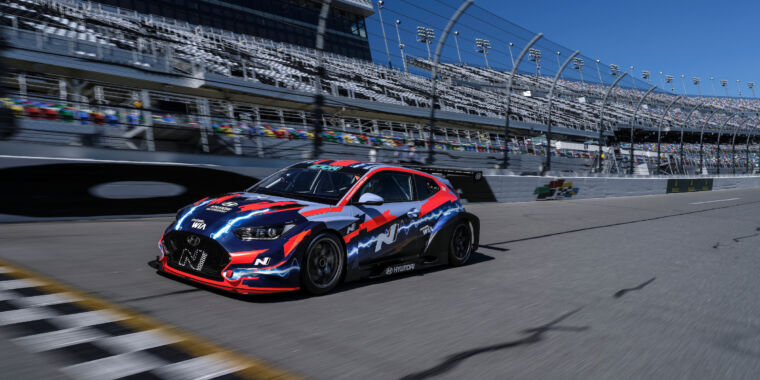
-
This is the Hyundai Veloster N ETCR, an electric racing car being developed for a new EV touring car category.LAT Images
-
The Veloster N ETCR conducted some demonstration laps at Daytona International Speedway in Daytona, Florida, the day before the Rolex 24 endurance race.LAT Images
-
Marcelo Lotti, World Sporting Consulting president, with IMSA President John Doonan and the Hyundai ETCR.LAT Images
The annual 24-hour race at Daytona International Speedway in Florida got underway on Saturday afternoon. And this year's race has been a pretty good one so far—although there are still nearly seven hours left to run as I write this. This year is the 59th running of a race that has become, unofficially at least, the start of the year's racing season for many. But on Friday, the 3.5-mile (5.6km) road course tried something new, when an electric racing car took to the track for some demonstration laps—the first time a racing EV has done so. With any luck, it may be a herald of things to come as the sport's organizers explore the potential for a US series in the next few years.
This wasn't a single-seater with open wheels like the cars that race in Formula E. Instead, it was designed for a new category called ETCR, for electric touring cars: think heavily modified road-going cars but with electric powertrains. In this case, that road-going car was a Hyundai Veloster N. Hyundai has been contesting the (not electric) TCR category with the Veloster N, but those all feature 2.0L internal combustion engines driving the front wheels.
The ETCR rulebook is much less restrictive, and as a result, the Veloster N ETCR is a much more exotic thing, with not one but four electric motors paired up so that each rear wheel is powered by a pair of motors. Peak power is an impressive 670hp (500kW)—as much as the new hybrid prototypes that will race at Le Mans from this year—drawing energy from a 68kWh battery pack sourced from Williams Advanced Engineering (which is also supplying Formula E with batteries for that series' third-generation car).
That makes it a challenging car to drive fast, according to Augusto Farfus, a professional racing driver who's working with Hyundai to develop the Veloster N ETCR car and who drove the demo laps at Daytona on Friday.
"The biggest difference is the noise, of course; we drive a car which is pretty much entirely silent. You can just hear the tires. And for me the biggest difference, besides the weight of the car—you get used to it fairly quickly—is the two rear wheels, which are not connected by anything. So we have four motors, two on the left rear and two on the right rear, but there is no rear differential like you would have in a normal race car," Farfus told Ars.
"It's a new challenge for the driver, because every single variation that you have on brake application, on the balance of the car on the brakes, becomes a major problem. You don't have engine braking, which overcomes some of these issues in a normal combustion car. So for me, this is the biggest difference. You approach the corners extremely fast, because 500 kilowatts does accelerate the car fairly quick, so you end up approaching a corner in complete silence, and super fast," Farfus said.
ETCR races promise to be action-packed, too, with short (6.2 miles/10km) sprint races planned for the Pure ETCR series that's due to get underway in Europe later this year. "You have to drive the car pretty hard. There is no energy management for the moment—there is no lift and coast or saving energy like we see in different electric formulas. So, this puts an extra pressure on the drivers and the engineers, because we have to develop a real race car with a real sprint spirit of attacking every, every lap," Farfus told me.
When Pure ETCR starts this year, the Veloster N ETCR will be joined by EV racers from three other makes: Seat, Alfa Romeo, and MG. IMSA, the organization that sanctions the Rolex 24 at Daytona (and top-level sports car racing in the US) isn't quite ready to announce a North American ETCR series, but IMSA President John Doonan sounded optimistic when asked about the prospects of such a thing happening.
"We want to be the platform. We want to be the opportunity in markets that make the most sense for the manufacturer partners so that the work that Marcelo [Lotti, president of World Sporting Consulting and the driving force behind both TCR and ETCR] and his team have done to get this to become reality is step one. Now, it's our responsibility to work with our existing manufacturers to see what they would like to do to leverage the opportunity," Doonan said.
"We're excited and honored to have this be the first time that a fully electric race car will have taken a demonstration lap—certainly not in competition, but we're thrilled to be part of this today. When an automaker utilizes one of our platforms to tell a story from a marketing standpoint, or from a new technology standpoint, that's right up our overall company strategy," Doonan told Ars.
Listing image by LAT Images
"electric" - Google News
January 31, 2021 at 10:45PM
https://ift.tt/36r4fxA
An electric race car has lapped Daytona for the first time - Ars Technica
"electric" - Google News
https://ift.tt/2yk35WT
https://ift.tt/2YsSbsy
Bagikan Berita Ini














0 Response to "An electric race car has lapped Daytona for the first time - Ars Technica"
Post a Comment